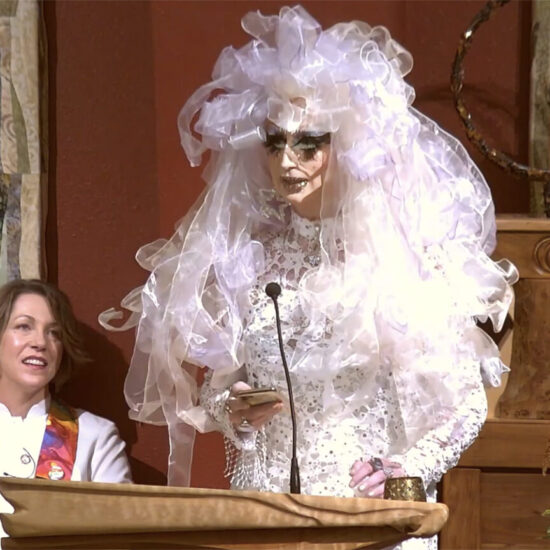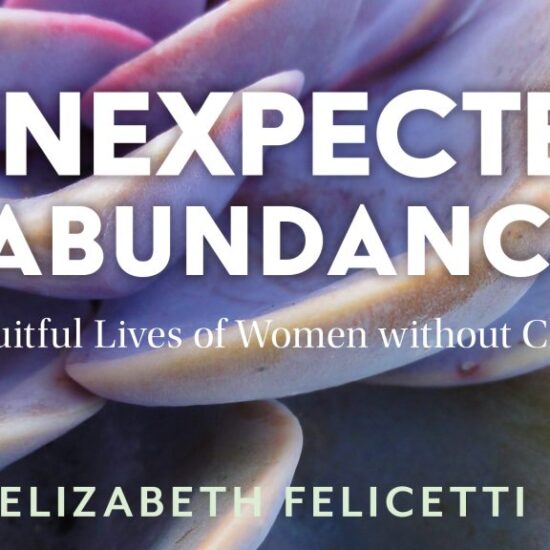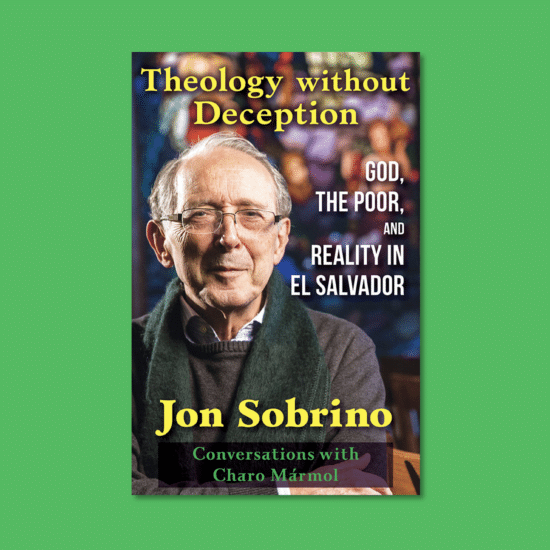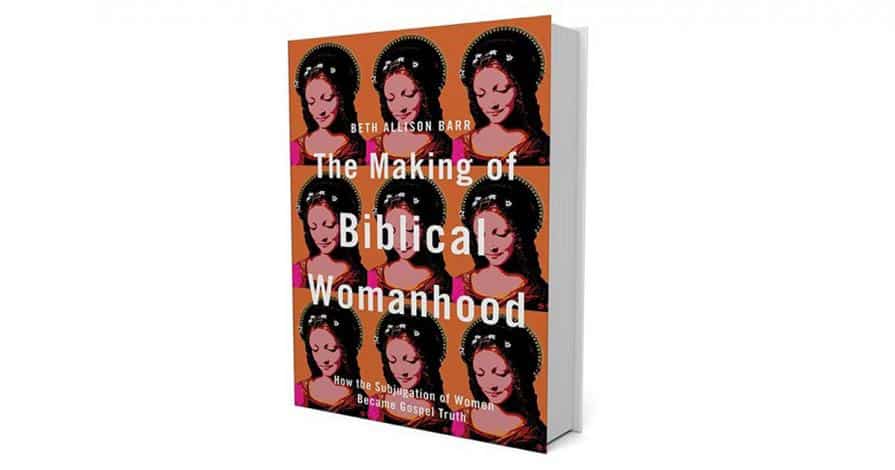
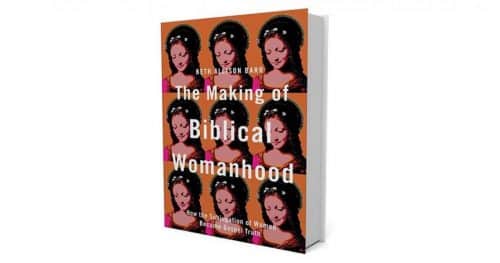
THE MAKING OF BIBLICAL WOMANHOOD: How the Subjugation of Women Became Gospel Truth. By Beth Allison Barr. Grand Rapids, MI: Brazos Press, 2021. X + 245 pages.
I am an ordained minister in a denomination that has elected two women as General Minister and President. While my denomination is out front in this area (I’m reminded that local congregations don’t always embrace women as their pastors even my denomination), that is not true everywhere. Some denominations, the Southern Baptist Convention, in particular, have even reversed course and ruled that women should not have any leadership roles where they might oversee or teach men. The leaders of the Convention have all embraced the ideology of complementarianism. This patriarchal ideology teaches that while men and women are equal before God when it comes to salvation, the same is not true when it comes to life on earth. Therefore, patriarchy is the rule. Men rule and women submit because that is the way God intended this to be from time immemorial. While that is the argument made by those who preach patriarchy, their position may not be fully rooted either in scripture or church history.

Robert D. Cornwall
Beth Barr’s The Making of Biblical Womanhood offers a rebuttal to patriarchalism and complementarianism. As such, the book is part memoir and part history. Barr is an accomplished medieval historian who grew up in and lived within the Southern Baptist Convention. While she accepted the message as true, eventually she began to question this view. Her own study of history contributed to it. So did personal experience. As for her credentials, she holds a Ph.D. from the University of North Carolina in History and currently serves as an associate professor of history and associate dean of the Graduate School at Baylor University.
For some of us who read this book, they will recognize elements of her story because we too were once indoctrinated in patriarchalism. That is true for me even though this indoctrination came during my sojourn within a denomination founded by a woman—the International Church of the Foursquare Gospel founded by Aimee Semple McPherson. Barr begins her story by introducing us to the ideology of patriarchy as expressed in the works and words of conservative evangelical leaders including John Piper, Paige Patterson, Wayne Grudem, Mark Driscoll, and Russell Moore. In laying out her case she addresses a distinction by some complementarians between pagan and Christian patriarchalism. She makes it clear that patriarchalism is patriarchalism, whether Christian or not, and it’s designed to justify male domination of women. Some patriarchalists like Mark Driscoll are militant in it, while others like Russell Moore offer softer versions. Whether militant or soft, adherents seek to justify the subjugation of women.
With this foundation laid out, Barr begins to unpack the so-called biblical and historical foundations of patriarchalism. To do this, she begins with Paul, who is often used in support of patriarchy. While Paul at times gives support to that view, she believes (as do I) that this is a misreading of Paul. Barr isn’t a biblical scholar. She’s a historian, and this is where she shines. Since she’s a medievalist, she introduces us to strong women leaders like Hildegard of Bingen (chapter 3). She notes that many of these women have essentially been written out of the story by modern church historians. She writes that “not only do these texts [she mentions several] contain very few references to female leaders in the medieval church; they minimize the authority of these women” (p. 97). From the medieval era, Barr moves to the Reformation era (chapter 4). She points out that the Reformation wasn’t exactly beneficial for women. This is especially true since monasticism, which gave women a place to develop their gifts and authority, was rejected, while the role of a wife was made the goal for women. The legacy of the Reformation for modern evangelical women has been extremely problematic. She points out that when it comes to Paul, it was the Reformation era leaders who began to use him to keep women from leadership roles. Thus, “instead of Scripture transforming society, society transformed how early modern Christians interpreted the Bible—and this was compounded (as we will see in the next chapter) by the proliferation of the English Bible” (p. 127).
As Barr noted at the end of chapter 4, the English Bible has influenced the way evangelicals and others have understood Scripture. In chapter 5, Barr focuses on the reaction among certain conservative evangelicals to a revision of the New International Version to make it read more inclusively. Led by people such as Wayne Grudem and James Dobson, the translators were accused of presenting a feminized Bible and taking men out of the Bible. That is, by using terms like human beings instead of mankind, men have been excised from the Bible. What Barr does here is show us that gender-inclusive language is not new. In fact, it’s there in medieval translations, so why are modern evangelicals so upset by efforts to make Scripture read more inclusively. Since most of us are dependent on translations, this is a most useful chapter.
In chapter 6, Barr brings out the practical implications of patriarchy. This chapter speaks of “Sanctifying Subordination.” One of the issues addressed here is the purity movement, which holds women responsible for male behavior. According to this viewpoint, women should be submissive and modest so that the boys and men won’t be led astray. The purity movement is accompanied by the ideology of domesticity. That is, women belong in the home and not in the workplace. Barr demonstrates that this ideology has its roots in the industrial revolution, which separated home and workplace in ways not seen before. Thus, the cult of domesticity emerged in the nineteenth century and ruled that women are to be kept separate and protected (especially white women, women of color of course were exempt since white women needed their help in the home).
As we turn to chapter 7, we begin to see more clearly how biblical womanhood takes shape in evangelicalism. Thus, in “Making Biblical Womanhood Gospel Truth,” Barr reminds the reader that at one time in the past, women were called upon to preach and evangelize. This was true even among Southern Baptists back in the 1930s. She reminds evangelicals that women once played an important role in the life of the church before things changed more recently. As she brings history into the conversation, she ventures into theology, where she describes how evangelicals, in their eagerness to define subordination, have embraced heresy. She suggests that the attempt to root the subordination of women in the Trinity is an expression of Arianism. In other words, leading evangelical theologians, like Bruce Ware, appear to have subordinated Jesus to the Father in such a way that Christ, the Son, may not share God’s substance (homoousious). Yes, could evangelicals have embraced heresy just so they can keep women in their place? Could the subordinationists rather than those who reject patriarchy be the real heretics? Who would have thought that evangelicals would go to such lengths as to embrace a view of Jesus rejected at Nicea?
As Barr brings The Making of Biblical Womanhood to a close, she brings home the question of the importance of freedom for women in the church. She brings into the conversation the #MeToo movement, sharing her own story of being abused, and suggesting, rightfully so, that patriarchalism contributes to this abuse. In making her case she points to the influence of Bill Gothard on evangelicalism. She doesn’t go into detail on Gothard’s views, but I know them well because I was introduced to them long ago. While I rejected them, I know that many in my circles wholeheartedly embraced them. While not everyone who embraced Gothard’s views is an abuser, if you take him literally, well, you could justify abuse. I remember the image he used to train up children. He pictured God taking a hammer (husband) and chisel (wife) to form the child into a proper Christian. In other words, God takes the hammer, hits the chisel, that hits the child. Do you see the problem here? In any case, the goal of this ideology is to keep men in control. If you don’t believe me, recently news came out that a famous megachurch pastor (John McArthur) excommunicated a woman because she left her abusive husband, a husband who had been on the staff of the school connected to the church. While the husband would eventually end up in prison because of his actions, it was the wife who was excommunicated from her by the pastor, who declared her to be an adulterer for leaving an abusive husband. Yes, the cult of biblical womanhood is dangerous.
Beth Barr’s book, The Making of Biblical Womanhood, may not describe the context in which I live, but I’ve been there and witnessed it. I even bought into it for a time, but fortunately, that’s not where I ended up. The fact is patriarchalism is still present within evangelicalism as seen in the devolution of the Southern Baptist Convention. But patriarchalism is really part of a larger ideological perspective that embraces authoritarianism in the church and society. Indeed, the doctrine of divine right monarchy was rooted in male headship in the home (see Robert Filmer’s Patriarcha, or the Natural Power of Kings (1680)). As I pointed out at the beginning of the review, The Making of Biblical Womanhood has elements of a memoir. Beth Barr lived this story, along with her husband, who lost his ministry position because he supported the full equality of women. Together they fought this battle, and now she tells the story in a way that sheds light on what is happening across evangelicalism. Thus, this is a most important book for our times.
This review originally appeared on BobCornwall.com.
Robert D. Cornwall is an ordained minister in the Christian Church (Disciples of Christ). Now retired from his ministry at Central Woodward Christian Church (Disciples of Christ) of Troy, Michigan, he serves as Minister-at-Large in Troy. He holds a Ph.D. in Historical Theology from Fuller Theological Seminary and is the author of numerous books including his latest books: Called to Bless: Finding Hope by Reclaiming Our Spiritual Roots (Cascade Books, 2021) and Unfettered Spirit: Spiritual Gifts for the New Great Awakening, 2nd Edition, (Energion Publications, 2021). His blog Ponderings on a Faith Journey can be found at www.bobcornwall.com.


